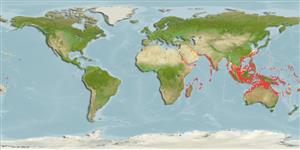Common names from other countries
Environment: milieu / climate zone / depth range / distribution range
Sinh thái học
Biển Cùng sống ở rạn san hô; Mức độ sâu 0 - 115 m (Ref. 123552), usually 3 - 60 m (Ref. 30874). Tropical; 30°N - 30°S, 32°E - 163°W
Indo-West Pacific: Red Sea and East Africa to Samoa, north to southern Japan and the Ogasawara Islands, south to Australia and Lord Howe Island.
Bộ gần gũi / Khối lượng (Trọng lượng) / Age
Maturity: Lm ? range ? - ? cm
Max length : 25.0 cm SL con đực/không giới tính; (Ref. 1602)
Các tia vây lưng cứng (tổng cộng) : 13; Các vây lưng mềm (tổng cộng) : 10 - 11; Tia cứng vây hậu môn: 3; Tia mềm vây hậu môn: 6 - 7. Body reddish with 5 dark bars, alternating with thin dark bars in large specimens; median fins with small dark spots; dark spot on cheek (Ref. 4313). Mid-dorsal spines longer than body depth (Ref. 37816).
Found on coral, rubble, or rock bottoms of reef flats (Ref. 9710); also in coastal to outer reef habitats in sheltered lagoons and in caves, sometimes in small aggregations. Usually shallow, from 3-60m (Ref. 30874) but also reported to 80 m depth. Pelagic stages travel great distances and expatriate to sub-tropical zones (Ref. 48635). Spawned in captivity (Ref. 37816). Spines with poison glands (Ref. 125576).
Life cycle and mating behavior
Maturities | Sự tái sinh sản | Spawnings | Egg(s) | Fecundities | Ấu trùng
Spawn in pairs. Courtship and spawning occur at night. Males aggressive, females are smaller and develop almost white face when in courtship. Spawning occurs at the apex of a short and rapid paired ascent resulting in a gelatinous mass of 2,000 to 15,000 eggs. Hatching occurs 36 hours later and larvae settle out in a few weeks at a size of 10-12 mm.
Matsunuma, M. and H. Motomura, 2019. Redescription of Dendrochirus zebra (Scorpaenidae: Pteroinae) with a new species of Dendrochirus from the Ogasawara Islands, Japan. Ichthyol. Res. 66(3):353-384. (Ref. 123552)
IUCN Red List Status (Ref. 130435)
CITES (Ref. 128078)
Not Evaluated
Human uses
Các nghề cá: buôn bán nhỏ; Bể nuôi cá: Tính thương mại
Các công cụ
Special reports
Download XML
Các nguồn internet
Estimates based on models
Preferred temperature (Ref.
115969): 24.3 - 29, mean 27.8 (based on 1518 cells).
Phylogenetic diversity index (Ref.
82804): PD
50 = 0.5078 [Uniqueness, from 0.5 = low to 2.0 = high].
Bayesian length-weight: a=0.01023 (0.00444 - 0.02358), b=3.01 (2.82 - 3.20), in cm Total Length, based on LWR estimates for this (Sub)family-body shape (Ref.
93245).
Mức dinh dưỡng (Ref.
69278): 4.0 ±0.66 se; based on food items.
Thích nghi nhanh (Ref.
120179): Trung bình, thời gian nhân đôi của chủng quần tối thiểu là 1.4 - 4.4 năm (Preliminary K or Fecundity.).
Fishing Vulnerability (Ref.
59153): Low vulnerability (21 of 100).
